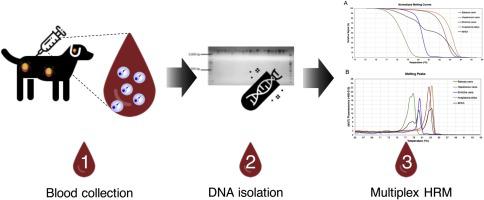Ticks and Tick-Borne Diseases ( IF 3.1 ) Pub Date : 2020-01-03 , DOI: 10.1016/j.ttbdis.2020.101370 Kittisak Buddhachat 1 , Tirawit Meerod 2 , Waranee Pradit 3 , Puntita Siengdee 4 , Siriwadee Chomdej 3 , Korakot Nganvongpanit 5

|
Recently, the incidence of canine infection by the tick-borne parasites Babesia spp., Hepatozoon canis, Ehrlichia canis and Anaplasma platys has been increasing globally. We have developed a multiplex high-resolution melting analysis (mHRM) technique to reduce the time demands and costs associated with detecting haemoparasites in canine blood, while increasing the degree of reliability of this method of analysis. We have designed primers that are specific for protozoans (B. vogeli and H. canis) and Rickettsia-like bacteria (E. canis and A. platys) based on the 18S or 16S rDNA sequences, respectively. Two primer pairs (Protz18S-C and Bact16S-A) were found to be suitable for detecting these agents since their melting temperatures (Tm) exhibited discernible differences among the four haemoparasites, A. platys, B. vogeli, E. canis and H. canis (83.10 °C, 82.41 °C, 80.37 °C and 78.56 °C, respectively). The sequences acquired from these PCR products were >94 % identical to those of A. platys, B. vogeli, E. canis and H. canis in GenBank. The limit of detection (LOD) for B. vogeli, E. canis and A. platys was 103 copies/μl, while the LOD for H. canis was 104 copies/μl. Of the 68 dogs tested, 28 (41 %) were infected with these agents. The most commonly occurring infection involved E. canis, followed by B. vogeli, A. platys and H. canis, with infection percentages of 26 %, 13 %, 7 % and 6 %, respectively. These results demonstrate that mHRM can serve as a rapid, economical and reliable tool for the detection of parasitic diseases in canine blood for diagnosis and epidemiology.
中文翻译:

同时鉴别犬血中的寄生虫:多重高分辨率熔解分析(mHRM)。
近来,由the传播的寄生虫巴贝斯虫,肝肝犬,埃里希氏犬和无浆虫感染犬的可能性在全球范围内正在增加。我们已经开发了一种多重高分辨率熔解分析(mHRM)技术,以减少与检测犬血中血寄生虫有关的时间要求和成本,同时提高了这种分析方法的可靠性。我们设计了对原生动物(B. vogeli和H. canis)和立克次体样细菌(E. canis和A. platys)具有特异性的引物)分别基于18S或16S rDNA序列。发现两个引物对(Protz18S-C和Bact16S-A)适用于检测这些试剂,因为它们的融解温度(T m)在四种嗜血寄生虫,板栗,伏牛肠,犬埃希菌和H中显示出可辨别的差异。canis(分别为83.10°C,82.41°C,80.37°C和78.56°C)。从这些PCR产物中获得的序列与GenBank中的板鸭,伏牛杆菌,犬埃希菌和犬埃希氏菌> 94%相同。检出限(LOD)为极限B. vogeli,犬埃里希氏体和板鸭为10 3拷贝/μl,而犬链球菌的LOD为10 4拷贝/μl。在测试的68条狗中,有28条(41%)被这些试剂感染。最常见的感染涉及犬埃里希氏菌,其次是B. vogeli,A。platys和H. canis,感染率分别为26%,13%,7%和6%。这些结果表明,mHRM可以作为一种快速,经济和可靠的工具,用于检测犬血中的寄生虫病以进行诊断和流行病学。











































 京公网安备 11010802027423号
京公网安备 11010802027423号